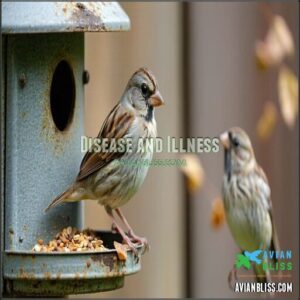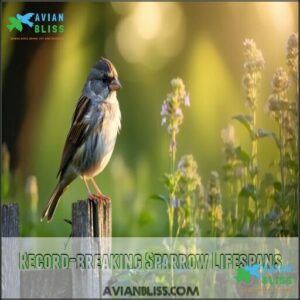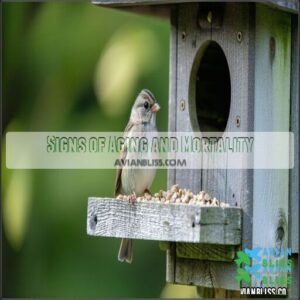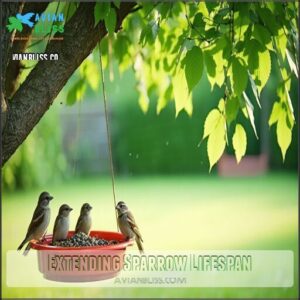This site is supported by our readers. We may earn a commission, at no cost to you, if you purchase through links.

In the wild, most sparrows live just 1-3 years, with many not making it past their first year. These little survivors face numerous threats including predators, disease, and habitat loss.
When you’re wondering how long do sparrows live, remember that captive sparrows fare better, often reaching 4-5 years and sometimes even 10 under ideal conditions. Their small size makes them vulnerable, but what they lack in longevity they make up for in resilience.
The secret to their occasional long life might surprise you when you understand their survival strategies.
Table Of Contents
- Key Takeaways
- Sparrow Lifespan Overview
- How Long Do Sparrows Live
- Sparrow Threats and Mortality
- Sparrow Conservation Status
- Sparrow Lifespan in Captivity
- Extending Sparrow Lifespan
- Frequently Asked Questions (FAQs)
- How long does a wild sparrow live?
- Do sparrows mate for life?
- What is the lifespan of a common sparrow?
- How long do sparrows live in captivity?
- Where do house sparrows live?
- How long does a tree sparrow live?
- How long do sparrows live in Florida?
- How long do fox sparrows live?
- What affects the lifespan of sparrows?
- Do House Sparrows Mate for Life?
- Conclusion
Key Takeaways
- Wild sparrows typically live just 1-3 years, with many not surviving their first year due to predators, disease, and habitat loss, while captive sparrows can reach 12-14 years and sometimes up to 23 years with proper care.
- You’ll find that 80% of young sparrows don’t make it to adulthood, facing threats from predators like hawks, cats, and snakes, as well as environmental challenges including window collisions, pesticide exposure, and habitat destruction.
- You can help extend sparrows’ lives by creating safer environments with predator protection (like hawk deterrents and keeping cats indoors), providing nutritious food (varied seeds and insect protein), and establishing toxic-free zones in your yard.
- House sparrows are mostly monogamous but not entirely faithful, with about 15% of offspring coming from relationships outside their main pair bond, and they’ve adapted to live across six continents, thriving wherever humans are present.
Sparrow Lifespan Overview
Sparrows might seem like tiny survivors, but most wild ones don’t make it past their first year due to predators and tough conditions.
For those that beat the odds, the average lifespan stretches to about 2 to 5 years, with a few extraordinary birds reaching impressive old ages.
Average Lifespan in Wild
Wild sparrows live short yet fascinating lives, with their lifespan shaped by natural selection and environmental pressures.
On average, the sparrow lifespan in the wild ranges from 2 to 5 years, though most face challenges that substantially shorten this window.
Young sparrows are particularly vulnerable, with juvenile mortality rates reaching a staggering 80% in their first year. For those that make it, adult sparrows exhibit a survival rate of 45-65% annually. Only an incredibly lucky few—about 1 in 1,000—live to 10 years.
Factors like predation, disease, and climate challenges heavily influence wild sparrow longevity.
Here are some key insights:
- Habitat quality: Sparrows thrive in safe, resource-rich environments.
- Species variation: Lifespan differs between species, with house sparrows averaging 3-5 years.
- Environmental pressures: Limited food and predators constantly test survival.
Understanding sparrow life expectancy builds appreciation for these resilient birds.
Average Lifespan in Captivity
Life in captivity transforms a sparrow’s lifespan dramatically.
With safe enclosures, steady nutrition, and veterinary care, sparrows can flourish for 12–14 years, far surpassing their wild life expectancy of 2–5 years.
Exceptional individuals can even live up to 23 years!
A balanced captive diet, spacious enclosures, and reduced stress all contribute to this extended sparrow lifespan.
Whether it’s a House Sparrow or Eurasian Tree Sparrow, proper care guarantees they age gracefully, chirping blissfully for years longer than their wild cousins, enjoying a longer lifespan.
Factors Affecting Lifespan
In terms of sparrow lifespan in the wild, a mix of challenges often shortens their years.
These birds face daily risks that keep survival an uphill battle.
Here’s how sparrow lifespan is affected:
- Predator Impact: Cats, hawks, and even snakes reduce sparrow populations by up to 60%.
- Disease Prevalence: Sparrow diseases like avian malaria and coccidiosis wreak havoc.
- Environmental Toxins: Pesticides and pollution poison their food and water.
- Injury Vulnerability: Window collisions and other accidents are surprisingly common.
- Human Activity: Habitat destruction and climate change disrupt breeding and food cycles.
For sparrows, every chirp is survival, coping with predators, diseases, and environmental threats every day.
How Long Do Sparrows Live
If you’ve ever wondered, “How long do sparrows live?” the answer varies quite a bit depending on their circumstances.
Sparrows in the wild often manage 3-5 years, battling predators and environmental challenges. In contrast, with proper captive care, their average lifespan jumps to 12-14 years, thanks to consistent food, safety, and shelter.
Here’s an engaging blockquote in the same tone as the text:
Wild sparrows fight daily battles to reach 5 years, while their pampered captive cousins can chirp happily for over a decade.
Remarkably, the oldest wild sparrow made it to nearly 16 years, and sparrows in ideal captivity settings have thrived up to 23 years. Sparrow aging depends heavily on their surroundings, social interactions, and access to resources.
Sparrows are mostly monogamous, and pair bonds strengthen through shared activities.
- Wild survival: 3-5 years on average
- Species longevity: House sparrows live longer than many others
- Environmental impact: Safer habitats mean higher sparrow survival rates
Sparrow Threats and Mortality
Sparrows face a host of challenges that shorten their lives, from predators like cats and hawks to environmental threats like habitat loss.
Understanding these risks helps you appreciate how these tiny birds survive despite the odds stacked against them.
Predation and Survival
Predators are the biggest challenge sparrows face, drastically impacting their survival rate.
Predators pose the greatest threat to sparrows, shaping their survival as they navigate a world filled with constant danger.
Roughly 80% of young sparrows don’t make it to adulthood, thanks to relentless natural selection.
Sparrow predators include hawks, owls, domestic cats, snakes, and even corvids—each with unique hunting styles.
Hawks and owls pick off adults in flight, while cats stalk fledglings leisurely like they’re sneaky villains in a nature movie.
Snakes raid nests for eggs, and corvids exploit unattended nests.
Your feathery little friends rely on survival strategies like flocking together and building nests in tricky spots.
Urban predators, such as housecats, make chicks incredibly vulnerable.
No surprise sparrow mortality remains so high—nature’s challenges are no small thing, and it’s due to nature’s challenges.
Environmental Impacts
Sparrows have more to worry about than predators lurking nearby. Environmental stressors are a major factor chipping away at their lifespan, keeping many from reaching their potential 3-5 years in the wild.
Climate change throws off natural rhythms, disrupting breeding and feeding cycles. Habitat loss adds to the struggle, as urban sprawl replaces nesting spots with pavement, forcing sparrows into less suitable areas.
And it doesn’t stop there—pollution and toxins in their environment play a quieter, but equally damaging, role.
- Window collisions kill millions annually, especially in urban spaces.
- Pesticides in food sources weaken sparrows over time.
- Pollution and noise make it harder for males to attract mates with their songs.
- Extreme weather events, like heatwaves, lead to food shortages.
- Toxins, such as methyl nitrite from unleaded petrol, harm populations.
Together, these challenges make survival an uphill battle for sparrows.
Disease and Illness
Bird diseases substantially shape sparrow lifespan, with issues like Avian Pox causing breathing and feeding difficulties.
Other threats, like Coccidiosis Impact, hit colonies hard, weakening birds through diarrhea and malnutrition.
Mite Infections drain essential energy, while illnesses like West Nile Virus bring neurological problems.
Staying proactive with Disease Prevention, such as cleaning feeders and reducing contamination, helps protect sparrow health.
Healthy habits guarantee these feathered friends live longer, even in challenging environments.
Human-related Threats
It’s surprising how human actions affect sparrows in big ways.
These tiny birds face challenges like:
- Window collisions, when they mistake glass for sky, leading to fatal injuries.
- Pesticide exposure, which kills insects sparrows count on for food.
- Habitat destruction from urban growth, leaving them without safe nesting spots.
- Nest removal during repairs, often wiping out eggs or chicks.
- Pollution impacts, contaminating food and water sources.
Simple changes, like using bird-safe glass or reducing pesticides, can make a huge difference.
You can also protect birds by creating safe habitats.
Sparrow Conservation Status
You’ve probably noticed fewer sparrows in your neighborhood, and it’s not just your imagination.
Conservation efforts focus on protecting their habitats, reducing human threats, and studying population trends to give these resilient little birds a fighting chance.
Habitat Preservation
If you want to help sparrows thrive, focus on preserving and restoring their habitats.
Urban greenery, like parks or small gardens, provides essential shelter and nesting sites, especially in areas facing habitat loss. Planting native plants attracts insects for food and offers natural cover.
Adding water sources, like birdbaths, keeps sparrows hydrated and healthy. Wildlife corridors allow these birds to move safely between fragmented spaces.
Efforts like these don’t just extend sparrow lifespans—they also boost local biodiversity. Think of it as creating a cozy, safe neighborhood for sparrows while protecting the environment.
Conservation efforts can truly make a lasting impact.
Reducing Human-related Threats
You’ve worked to protect sparrow habitats, but human-related threats still impact their survival.
Small changes in daily life can make a big difference in reducing risks like window collisions, predators, and exposure to harmful substances.
Here’s how you can help:
- Add decals or screens to windows to prevent fatal collisions.
- Use pesticide alternatives in gardens to guarantee a safer environment.
- Keep cats indoors or use bell collars to deter hunting.
- Regularly clean bird feeders to stop diseases from spreading.
- Support protected nesting areas and avoid disturbing natural sites.
By addressing these issues, you’ll help sparrows live longer and thrive in our shared environment. Understanding habitat loss implications is vital for effective conservation.
Monitoring and Research Initiatives
Understanding sparrows better takes clever tracking and careful study.
Scientists use tools like GPS microtagging and bird-banding to track sparrow populations and answer questions like, "How long do sparrows live?"
These methods reveal the average sparrow lifespan of 3–5 years in the wild, though predators and environmental factors claim many lives early.
Citizen science programs, where everyday folks help count nests or track sightings, play a big role in bird research.
These programs can substantially improve data accuracy.
Habitat monitoring and population censuses uncover critical insights—like how only 20% of sparrows reach adulthood.
Data analysis from these bird studies helps direct research funding to where it’s needed most, which can lead to conservation impact and inspires hope for protecting sparrows from vanishing like yesterday’s crumbs at a picnic, highlighting the importance of citizen science programs and research funding.
Sparrow Lifespan in Captivity
In captivity, sparrows can live much longer, often reaching 12 to 14 years due to reduced threats and consistent care.
With proper food, shelter, and protection, some even set impressive records, far outliving their wild relatives, which is a notable aspect of their survival in captivity.
Record-breaking Sparrow Lifespans
Some sparrows break all the lifespan records, living far beyond the average 3-5 years.
These exceptional cases showcase what’s possible under perfect conditions.
Record-breaking sparrows that amaze researchers include:
- A wild house sparrow reaching an incredible 15 years and 9 months
- A captivity champion living 23 years (nearly 5 times the typical lifespan)
- A banded White-crowned Sparrow documented at 13 years, 4 months
- Song Sparrows occasionally surviving past 11 years when environmental factors align perfectly
You’ll rarely witness these bird Methuselahs in your backyard!
Signs of Aging and Mortality
As captive sparrows approach their final years, most exhibit definitive signs of aging long before reaching those record-breaking 20-year lifespans.
You’ll notice your aging bird developing duller plumage changes and feather loss, alongside increasingly lethargic behavior and reduced mobility when moving between perches.
The sparrow age when mortality rates climb substantially is around 10 years in captivity. At this stage, providing softer foods, lower perches, and a stress-free environment becomes vital.
| Aging Signs | Common Causes of Death |
|---|---|
| Trouble flying | Organ failure |
| Reduced singing | Respiratory disease |
| Decreased appetite | Nutritional deficiency |
| Visible injuries | Infections |
| Less social activity | Age-related illness |
These adjustments won’t reverse aging but can guarantee your feathered friend’s remaining time is comfortable despite their inevitable decline in health.
Dietary Needs in Captivity
Through proper nutrition, captive sparrows can thrive for years beyond their wild counterparts.
Your bird needs a balanced diet mixing quality seeds (millet, canary seed) with protein sources like mealworms and occasional insectivore supplements.
Fresh greens and fruits provide essential vitamins, while clean water must be available daily.
Different sparrow species have unique nutritional needs, so research your specific bird’s preferences.
Prevent obesity by limiting high-fat seeds and encouraging foraging enrichment.
Scatter food in different locations or use puzzle feeders to stimulate natural behaviors.
Never offer foods with insecticides or artificial additives, as this can harm your bird’s health and well-being, affecting their ability to thrive in captivity.
Extending Sparrow Lifespan
You can help your backyard sparrows live longer by creating safer environments with predator protection, clean feeding stations, and toxin-free spaces.
With these simple changes to your yard, you’ll transform it into a sparrow sanctuary where these tiny birds might live up to 5 years instead of the typical 2-3 years in the wild, which can be considered a significant increase in their lifetime.
Reducing Predation Risks
By taking action against predators, you’ll help sparrows live longer in your backyard and beyond. Predators like cats and hawks cause over half of all sparrow deaths!
Try these four proven protection strategies:
- Hang shiny items or reflective tape as hawk deterrents around feeders
- Install predator guards on nest boxes to block climbing threats
- Keep cats indoors or add bells to collars (cat predation is deadly!)
- Place birdhouses 6-8 feet high, away from where squirrels can jump
Consider using reflective deterrent tape to further discourage hawks, and remember that predators like cats and hawks are a significant threat, making protection strategies crucial for the sparrows’ survival.
Providing Nutritious Food
Nourishment serves as the cornerstone of a healthy sparrow life, directly influencing how long these birds thrive.
You can boost their nutritional intake with thoughtful food offerings.
- Seed Variety: Mix sunflower, millet, and nyjer seeds for essential oils and nutrients
- Insect Protein: Provide mealworms or dried insects, especially during breeding season
- Calcium Sources: Offer crushed eggshells or cuttlebone for stronger bones
- Fresh Water: Keep clean water available alongside bird feeders
- Feeding Frequency: Maintain consistent food availability year-round
Regular access to high-quality bird seeds supports sparrow diet needs.
Many enjoy providing sunflower seeds to attract them.
Think of your feeder as their grocery store—when it’s stocked with nutritious options, they’ll shop there happily!
Creating Safe Habitats
Beyond providing nutritious food, creating safe habitats dramatically extends your sparrows’ lifespans.
Set up nest boxes in sheltered spots 5-12 feet high, away from predator access points.
This Safe Nesting approach creates birdsafe environments where sparrows can thrive.
You can find suitable sparrow shelters to further enhance their habitat.
Install Clean Feeders nearby—but not too close to nesting sites—to prevent attracting unwanted visitors.
Establish Toxic-Free Zones by avoiding pesticides in your yard.
Incorporate native plants for Habitat Enrichment, creating natural cover and food sources.
These bird conservation efforts support complete ecosystems where sparrows find everything they need.
Remember: good sparrow habitat design isn’t just about survival—it’s about helping these delightful birds truly flourish.
Minimizing Human-related Threats
After building safe places for sparrows to live, you’ll want to reduce human dangers too.
You can help sparrows live longer by:
- Applying window decals or strips to prevent fatal collisions
- Using natural pesticide alternatives like neem oil or diatomaceous earth
- Keeping feeders clean with regular bleach solution washing
- Monitoring outdoor pets especially during nesting season
These birdfriendly practices but also protect individual birds and support sparrow conservation efforts in your community.
Frequently Asked Questions (FAQs)
How long does a wild sparrow live?
Wild sparrows typically live 2-5 years in their natural habitat, though many don’t survive their first year.
You’ll find that some exceptional birds can reach 10-15 years if they avoid predators and disease.
Do sparrows mate for life?
See those house sparrows in your backyard?
They’re like old married couples.
You’ll find they typically mate for life, though they’re not always faithful—about 15% of offspring come from flings outside their main relationship.
What is the lifespan of a common sparrow?
Common sparrows typically live 2-5 years in the wild, though you’ll find many don’t survive their first year.
In captivity, they can reach 12-14 years, with record lifespans stretching to 23 years.
How long do sparrows live in captivity?
Sparrows enjoy surprisingly long lives in captivity, typically 12-14 years with proper care.
You’ll find some house sparrows can survive up to 23 years when they’re protected from predators and have consistent food sources.
Where do house sparrows live?
Contrary to their forest-dwelling cousins, you’ll find house sparrows almost everywhere humans are.
They’ve made their home across six continents, thriving in cities, farms, and suburbs while avoiding extensive woodlands, polar regions, and hot deserts.
How long does a tree sparrow live?
Tree sparrows typically live 3 years in the wild, though you’ll find some reaching up to 12 years.
In captivity, they’ll often survive longer—between 4-5 years—thanks to protection from predators and consistent food.
How long do sparrows live in Florida?
In Florida’s warm climate, you’ll find sparrows typically living 2-5 years in the wild.
With fewer harsh winters to contend with, they might enjoy slightly longer lifespans than their northern counterparts.
How long do fox sparrows live?
Nearly 20% of fox sparrows reach their 3rd birthday! You’ll find these resilient birds living up to 10 years in the wild, though their average lifespan typically ranges between 3-5 years.
What affects the lifespan of sparrows?
Several factors impact a sparrow’s life: predators like cats and hawks, diseases, parasites, habitat quality, food availability, climate change, and human activities.
You’ll notice wild sparrows rarely live beyond their first year without these threats.
Do House Sparrows Mate for Life?
No, House Sparrows don’t mate for life.
They’re socially monogamous during breeding seasons but often find new partners each year.
You’ll sometimes see them cheating on their current partners when opportunities arise.
Conclusion
Remarkably, only 30% of sparrows survive their pivotal first year of life.
When you’re asking how long do sparrows live, remember it’s all about adaptability—these resilient birds face countless dangers yet continue to thrive in diverse environments.
Whether living their brief 1-3 years in the wild or enjoying extended lives in captivity, sparrows make the most of their time.
You can help extend how long sparrows live by providing safe habitats and nutritious food in your backyard.
- https://ca.audubon.org/news/oldest-recorded-rufous-crowned-sparrow-found-audubon-starr-ranch
- https://www.fws.gov/story/threats-birds-collisions-road-vehicles
- https://scitechdaily.com/predator-prey-dynamics-evolution-happens-faster-than-expected/
- https://www.msdvetmanual.com/poultry/coccidiosis/overview-of-coccidiosis-in-poultry
- https://www.allaboutbirds.org/guide/House_Finch/id













